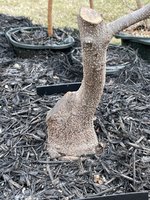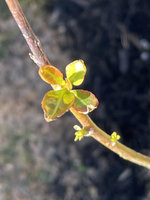Maiden69
Masterpiece
Hi, I got this tree that I moved from the front of the house because we are in a new community and the deers kept eating it all the time. In its place I planted a blue point juniper and so far I haven't seen the deers back in my front yard. I cut all the branches that were chewed up and by the time I was done I didn't like what I had, so I pretty much chopped the thing down.
It is beginning to leaf out now and was wondering if you guys knew what kind of tree it is. I thought it is either a red photinia, but one of the builders says he thinks it may be a Japanese blueberry. I plan on either thread or approach graft that long whip on the lower portion of the chop (it is very flexible right now, or air layer it and then graft it. Now that is if it is worth something as a bonsai and it is not one of those species that are very hard to work on.
Thanks.



It is beginning to leaf out now and was wondering if you guys knew what kind of tree it is. I thought it is either a red photinia, but one of the builders says he thinks it may be a Japanese blueberry. I plan on either thread or approach graft that long whip on the lower portion of the chop (it is very flexible right now, or air layer it and then graft it. Now that is if it is worth something as a bonsai and it is not one of those species that are very hard to work on.
Thanks.






